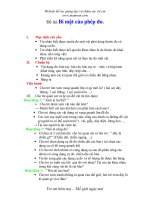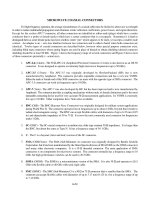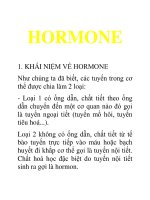Tài liệu Coaxial docx
Bạn đang xem bản rút gọn của tài liệu. Xem và tải ngay bản đầy đủ của tài liệu tại đây (192.12 KB, 3 trang )
6-3.1
MICROWAVE COAXIAL CONNECTORS
For high-frequency operation, the average circumference of a coaxial cable must be limited to about one wavelength
in order to reduce multimodal propagation and eliminate erratic reflection coefficients, power losses, and signal distortion.
Except for the sexless APC-7 connector, all other connectors are identified as either male (plugs) which have a center
conductor that is a probe or female (jacks) which have a center conductor that is a receptacle. Sometimes it is hard to
distinguish them as some female jacks may have a hollow center "pin" which appears to be male, yet accepts a smaller male
contact. An adapter is an . zero loss interface between two connectors and is called a barrel when both connectors are
identical. Twelve types of coaxial connectors are described below, however other special purpose connectors exist,
including blind mate connectors where spring fingers are used in place of threads to obtain shielding (desired connector
shielding should be at least 90 dB). Figure 1 shows the frequency range of several connectors and Figure 2 shows most
of these connectors pictorially (. actual size).
1. APC-2.4 (2.4mm) - The 50 S APC-2.4 (Amphenol Precision Connector-2.4 mm) is also known as an OS-50
connector. It was designed to operate at extremely high microwave frequencies (up to 50 GHz).
2. APC-3.5 (3.5mm) - The APC-3.5 was originally developed by Hewlett-Packard (HP), but is now
manufactured by Amphenol. The connector provides repeatable connections and has a very low VSWR.
Either the male or female end of this 50 S connector can mate with the opposite type of SMA connector. The
APC-3.5 connector can work at frequencies up to 34 GHz.
3. APC-7 (7mm) - The APC-7 was also developed by HP, but has been improved and is now manufactured by
Amphenol. The connector provides a coupling mechanism without male or female distinction and is the most
repeatable connecting device used for very accurate 50 S measurement applications. Its VSWR is extremely
low up to 18 GHz. Other companies have 7mm series available.
4. BNC (OSB) - The BNC (Bayonet Navy Connector) was originally designed for military system applications
during World War II. The connector operates best at frequencies up to about 4 GHz; beyond that it tends to
radiate electromagnetic energy. The BNC can accept flexible cables with diameters of up to 6.35 mm (0.25
in.) and characteristic impedance of 50 to 75 S. It is now the most commonly used connector for frequencies
under 1 GHz.
5. SC (OSSC) - The SC coaxial connector is a medium size, older type constant 50 S impedance. It is larger than
the BNC, but about the same as Type N. It has a frequency range of 0-11 GHz.
6. C - The C is a bayonet (twist and lock) version of the SC connector.
7. SMA (OSM/3mm) - The SMA (Sub-Miniature A) connector was originally designed by Bendix Scintilla
Corporation, but it has been manufactured by the Omni-Spectra division of M/ACOM (as the OSM connector)
and many other electronic companies. It is a 50 S threaded connector. The main application of SMA
connectors is on components for microwave systems. The connector normally has a frequency range to 18
GHz, but high performance varieties can be used to 26.5 GHz.
8. SSMA (OSSM) - The SSMA is a microminiature version of the SMA. It is also 50 S and operates to 26.5
GHz with flexible cable or 40 GHz with semi-rigid cable.
9. SMC (OSMC) - The SMC (Sub-Miniature C) is a 50 S or 75 S connector that is smaller than the SMA. The
connector can accept flexible cables with diameters of up to 3.17 mm (0.125 in.) for a frequency range of up
to 7-10 GHz.
CONNECTOR TYPE
Note: Just because connectors can be
connected together, doesn't mean they
will work properly with respect to power
handling and frequency.
6-3.2
Figure 1. Frequency Range of Microwave Connectors
10. SMB (OSMB) - The SMB is like the SMC except it uses quick disconnect instead of threaded fittings. It is
a 50 / 75 S connector which operates to 4 GHz with a low reflection coefficient and is useable to 10 GHz.
11. TNC (OST) - The TNC (Threaded Navy Connector) is merely a threaded BNC. The function of the thread
is to stop radiation at higher frequencies, so that the connector can work at frequencies up to 12 GHz (to 18
GHz when using semi-rigid cable). It can be 50 or 75 S.
12. Type N (OSN) - The 50 or 75 S Type N (Navy) connector was originally designed for military systems during
World War II and is the most popular measurement connector for the frequency range of 1 to 11 GHz. The
precision 50 S APC-N and other manufacturers high frequency versions operate to 18 GHz.
Note: Always rotate the movable coupling nut of the plug, not the cable or fixed connector, when mating
connectors. Since the center pin is stationary with respect to the jack, rotating the jack puts torque on the center
pin. With TNC and smaller connectors, the center pin will eventually break off.
An approximate size comparison of these connectors is depicted below (not to scale).
Large ======================== Medium ======================= Small
SC 7mm N TNC/BNC 3.5mm SMA 2.4mm SSMA SMC
APC 2.4 Jack - APC 3.5 Jack
SSMA Jack - BNC Jack
Type N Jack - TNC Jack
SMA Plug - TNC Plug
SC Jack - Type N Jack
Type N Plug - TNC Jack
Waveguide - 7mm
Waveguide - SMA Jack
Double ridge
7mm - 3.5mm Plug
SMC Plug - SMA Jack
Standard
6-3.3
Figure 2. . Microwave Coaxial Connectors (Connector Orientation Corresponds to Name Below It)
Figure 2. Microwave Coaxial connectors (Continued)









